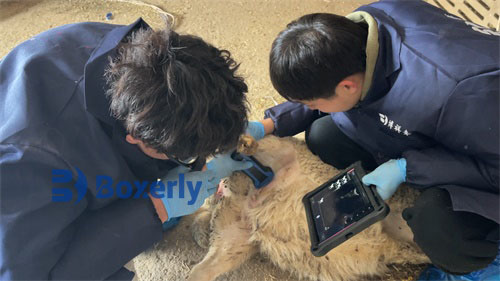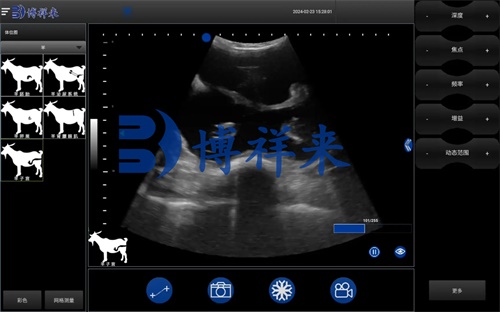As sheep farmers around the world strive to improve reproductive efficiency, reduce costs, and accelerate genetic progress, estrus synchronization has become an indispensable reproductive technology. The ability to manage and synchronize estrus cycles in large groups of ewes not only facilitates artificial insemination and embryo transfer programs but also ensures a more uniform lambing season and better herd management. Among the critical tools enabling the success of estrus synchronization, sheep-specific ultrasonography—particularly B-mode ultrasound—plays a pivotal role.

Ultrasound allows for precise, real-time evaluation of reproductive status, follicular development, pregnancy diagnosis, and ovulation timing, making it an essential partner technology in modern reproductive biotechnologies. In this article, we explore how sheep ultrasonography is used to support estrus synchronization, drawing from both global scientific understanding and practical experience on farms in countries like Australia, the UK, and China.
Understanding Estrus Synchronization in Ewes
Estrus synchronization refers to the deliberate regulation of the estrous cycle so that a group of female sheep come into heat simultaneously. Typically achieved through hormonal protocols (such as progesterone-releasing devices combined with prostaglandins and eCG), this method allows farmers to control the timing of breeding.
Globally, farmers and veterinarians recognize several benefits to estrus synchronization:
-
Reduces the need for large numbers of rams.
-
Facilitates genetic improvement through AI and embryo transfer.
-
Produces a more uniform lamb crop.
-
Optimizes labor efficiency and veterinary care.
-
Shortens generational intervals and accelerates breeding goals.
However, for these benefits to be fully realized, it is crucial to accurately monitor the reproductive cycle—this is where ultrasonography comes in.
Ultrasound as a Monitoring Tool for Synchronization
Ultrasound is a non-invasive imaging technique that uses high-frequency sound waves to visualize internal organs. In sheep reproduction, B-mode (brightness mode) ultrasound is commonly used to observe the uterus, ovaries, and pregnancy status. The key applications of ultrasonography during estrus synchronization include:
-
Pre-synchronization Evaluation
Before initiating hormonal treatments, ultrasound can determine if the ewe is cycling normally or if there are any pathologies (e.g., cysts, endometritis) that might hinder synchronization. This allows for selecting the right candidates and excluding those unlikely to respond. -
Follicular Monitoring
In many advanced breeding programs, especially in Europe and Australia, ultrasound is used to track follicular development on the ovaries during synchronization protocols. This ensures optimal timing for AI or natural mating and can improve conception rates. -
Post-Insemination Pregnancy Diagnosis
One of the most common uses of sheep ultrasonography is early pregnancy diagnosis, typically from day 25 onward. Devices such as the Boxianglai sheep ultrasound scanner have become popular among Chinese and international producers for their portability, ease of use, and ability to scan without shaving the ewe’s abdomen. -
Embryo Transfer Management
Estrus synchronization is a prerequisite for successful embryo transfer (ET), as it ensures the donor and recipient ewes are at compatible stages of the reproductive cycle. Ultrasound is used to assess uterine readiness and confirm ovulation before embryo implantation.

Real-World Applications: Global Perspectives
In countries like the UK and Australia, estrus synchronization combined with ultrasonography is standard in pedigree flocks and commercial operations. For example, large-scale sheep farms in New South Wales report using ultrasonography to synchronize estrus in 300+ ewes for AI within a 3-day window. This is followed by real-time ultrasound to detect pregnancy and manage the flock accordingly.
Meanwhile, in China, the rapid adoption of ultrasonography in sheep production—especially by companies like Boxianglai—has improved reproductive outcomes significantly. Their hand-held, hair-free ultrasound scanner helps farmers quickly identify pregnant ewes and track reproductive health without causing stress or requiring restraint.
Ultrasound Enhances Genetic Progress and Productivity
The combination of estrus synchronization and ultrasound supports rapid genetic advancement. Here’s how:
-
High-performing rams and ewes can be selected based on ultrasound-assisted evaluation of reproductive and muscular traits.
-
Synchronization allows for mass artificial insemination, concentrating elite genetics into a single breeding window.
-
Embryo transfer programs benefit from synchronized donors and recipients, increasing the success rate of implantation.
This has allowed farmers worldwide to shorten generational intervals, maximize the reproductive potential of high-value females, and produce uniform, high-quality offspring.

Health and Welfare Advantages
Ultrasound also contributes to improved animal welfare and herd health management. Regular scanning helps identify reproductive disorders early, reducing infertility cases and ensuring only healthy animals enter synchronization programs. Moreover, the non-invasive nature of ultrasound minimizes stress compared to more invasive diagnostics.
Technical Advancements in Sheep Ultrasonography
Modern sheep ultrasound devices have seen significant innovation in the last decade. Features like:
-
Hair-free scanning: No need to shave the ewe, which is particularly helpful in field conditions.
-
Lightweight and portable: Useful for remote operations.
-
Real-time imaging: Enables on-the-spot decisions during AI and ET.
Systems like those offered by Boxianglai incorporate ergonomic design with veterinary-specific imaging algorithms, making them a favorite among commercial producers in Asia and beyond.

Challenges and Considerations
Despite the advantages, several challenges remain in applying ultrasound to estrus synchronization:
-
Operator training: Successful imaging requires skilled technicians.
-
Equipment cost: Although prices are dropping, ultrasound devices still represent a significant investment for smallholders.
-
Environmental factors: Weather and field conditions can affect scanning accuracy.
However, as technology becomes more affordable and training more accessible, these challenges are being gradually overcome.
The Future of Sheep Reproduction: Integration with Other Technologies
Ultrasound is increasingly being integrated with other technologies, such as:
-
Electronic identification (EID): Linking reproductive data to individual animals.
-
Cloud-based farm software: Real-time reproductive tracking across flocks.
-
Genomic selection: Choosing animals for synchronization based on genetic markers and ultrasound traits.
This fusion of genetics, ultrasound, and data science is transforming sheep reproduction into a more precise, data-driven discipline.
Conclusion
Estrus synchronization in sheep, when combined with ultrasonography, offers a powerful method for improving reproductive efficiency, enhancing genetic gain, and promoting animal welfare. As global producers adopt these technologies, the integration of ultrasound into routine reproductive management will become even more critical.
From Australia to China, farmers are discovering that having a reliable ultrasound system is not just a diagnostic tool—it’s a cornerstone of a modern, sustainable sheep enterprise. By enabling more informed decisions at every stage of the reproductive cycle, ultrasonography helps turn synchronization protocols into real-world success stories.